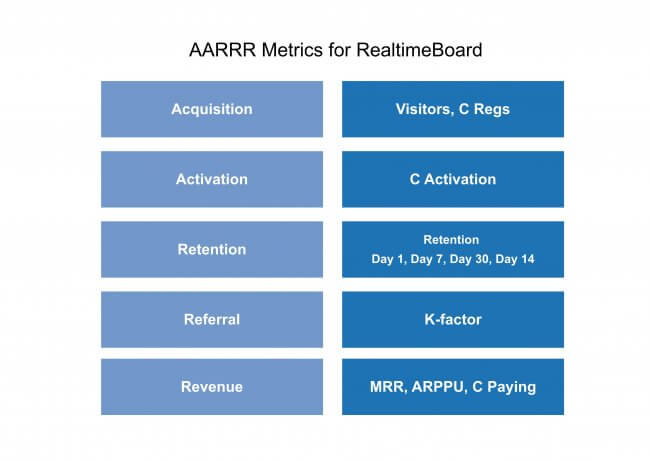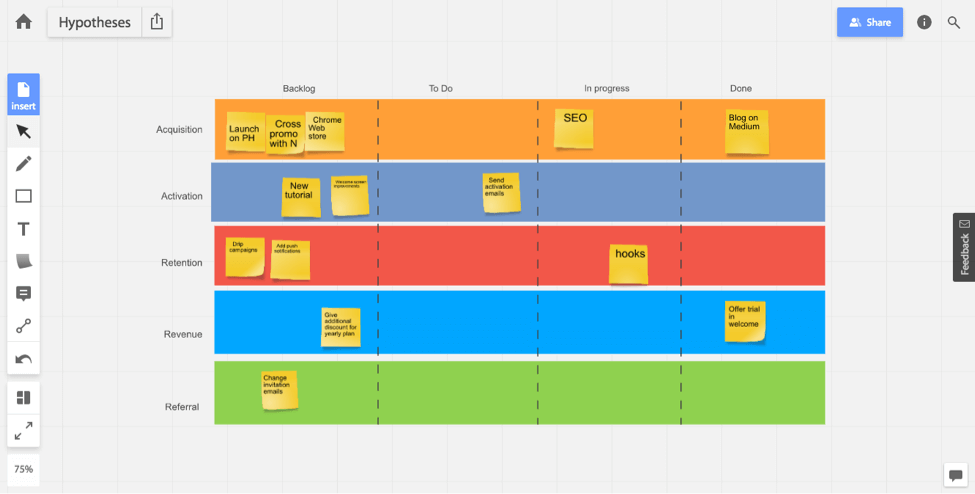How do you speed up growth? Of course, it’s about your team, product, and “growth hacks” (which you are using) but in order to build long-term success, your process and approach needs to be more in depth than just cobbling together a series of hacks, and hoping for the best.
Setting up the right process for your agile marketing team will help you become not a one-day hacker, but a successful growth master. Just like software companies use agile practices to build products, marketers can implement an Agile approach for their growth process and ultimately spend less to achieve their goals. The Agile marketing strategy described in this article helped us acquire more than 1 million users, and we are happy to share some insights, which you can implement with your team!
And if you haven’t read our visual guide to Agile that also goes into the concepts of Lean, Scrum and Kanban, make sure you do before going further on this one. It’s going to give you a better grasp on definitions and concepts.
What is agile marketing?
Agile marketing is the application of Agile methodology (developed for software development) to marketing: it involves a step-by-step iterative process in which underlying assumptions are constantly tested in quick sprints. The process is driven by continuous feedback from target personas and agile reactivity to overall shifts in the market.
The agile marketing process in 6 steps
The growing popularity of growth hacking in the past few years has resulted in a lot of marketers (especially if they are taking their first steps in this area) trying to “hack” growth. It’s true that you can search the Internet, collate a collection of random “hacks” and prepare 100 experiments in a single month, and then hope for the best. Some of them will probably even work! But the objective should not be to apply as many hacks as possible, but rather to deliver the right product for the right audience in the right time and place.
We at Miro experimented a lot and came to the conclusion that a kind of system of experiments gives us great results. So, we decided to refine our marketing process and adopted an agile framework from our agile development team.
Step 1. Choose metrics that matter
All the goals of your marketing campaign should be measurable, so you will need some indicators, which can show you if you are moving in right direction. We are using a widely known concept — AARRR metrics by Dave McClure.

3 tips on how to work with metrics:
- Implement an analytic system, which will help you collect and analyze your data. We are using KISSmetrics and Google Analytics, but there are a lot of other systems that are worth a look, i.e. Amplitude or Mixpanel. It’s better to measure everything you can from the very beginning, as this will help you make decisions that are data-driven and allow you to test your hypotheses.
- If there is a specific step in your product funnel that you want to focus on, you can add an additional element to this process — a specific metric to measure. I.e., if you are offering Free trial and Free limited plan at the same time, you can include the number of trials in the AARRR funnel.
- One metric that can be difficult to “discover” and measure properly is Activation. Activation is all about that “a-ha moment”, and the particular element that led to this moment often cannot be simply measured. To define what activation for your product or service is, you will need to study the common patterns among your returned visitors — in order to study what is successful, you will need to find these users and analyze what they did during their first session. Analytic systems help you discover what user actions led to active usage, and then interviews help you support data with empathy and emotional context. In the picture below you can see data about active usage of different features by returned and one-day users.

Step 2. Find your goals and pace
Everything starts with the goal. For our purposes, each AARRR letter is assigned as a quarterly goal. For example: Q1 Activation: Increase Activation by 10%. Obviously, it’s not only hard to focus on too many things at the same time, but trying to do too much at once can be detrimental to your team’s overall effectiveness, and the successful completion of your goals. It is better to define one or two priorities at a time, and put the other metrics in a holding pattern (i.e. just support acquisition on the same level).
Once the Quarter goal is defined, the next step is to plan your Sprints. A Sprint is a limited period of time when you are conducting a number of experiments and completing tasks to achieve a Sprint goal. When the Sprint ends, you can measure the results, and analyze what works better. We highly suggest you to make a Retrospective before planning your next Sprint. (See step six for why!)
The length of the Sprint is defined by the team. For us, two week Sprints are ideal, but you can vary it depending on the following things:
- Time you and your team need to launch an experiment
- Resources you have
During our two-week Sprint cycle we have several types of meetings: Sprint planning meeting, Operational meeting to check if everything goes well, and Retrospective. While we do not always do so, some teams find it useful to also have daily Stand Ups, and if this practice works for you, we encourage you to use it. As always, you should use these tips as a framework to guide the development of your own plan based on your team’s needs.
For remote team members we use Miro and Google Docs, as this allows everyone to be involved and active; it helps us keep everybody on the same page.
Step 3. Generate hypotheses — build your growth backlog
Now it’s time to create a backlog of hypotheses you and your team will test. To find the hypotheses, you can analyze your data to find some insights, or find inspiration in related articles. Once the gathering of ideas based on the evaluation of the metrics has been completed, the ideas are added to the Growth Backlog. We then choose some of them for future evaluation. Each member of our Growth team contributes to the backlog, which is divided into 5 blocks, each corresponding to an AARRR metric. You can see an example of this below:

Step 4. How to choose what to test next — ICE framework
Sean Ellis introduced the ICE Score framework which helps your team evaluate all the hypotheses before you start investing in building and testing anything.
In order to make the best use of your time, and determine how to prioritize items for your next Sprint, there are three questions which you and your team should answer:
- What will the impact be if this works? (from 1 to 5)
- How confident are we that this will work? (from 1 to 5)
- How easy is it to build/implement? (from 1 to 5, the easier the thing is to implement, the higher score it has).

When all the things are evaluated, you get an ICE score as a sum of I+C+E.
The hypotheses with the highest ICE score are prioritized for the next Sprint and go to To-Do section; the team will work on them for the next two weeks, and then the Agile process will begin again, with a re-evaluation of your hypotheses to ensure that the items with the highest ICE scores are always being focused on first.
What if’s
- What if a great hypotheses came to me in when the Sprint has already started? Even if it seems great, put it to your backlog. Team members shouldn’t be interrupted if they have already started their work. This just creates confusion.
- What if the team cannot do all the tasks during the Sprint? It’s all about accurately judging your team velocity. If you find that you are unable to complete all of the tasks, at the end of the Sprint, hold a retrospective to analyze what went wrong and correct your planning.
- What if the idea has a high score, but I don’t believe that it will actually work? Frameworks are great, but you should also follow your gut feelings! The more you test, the more precise predictions you will get.
Step 5. Test and analyze
Great! You’ve just launched your first experiment. When the test starts, we collect data from various sources on one board. The whole Growth team has access to this board:

It’s hard to imagine our life without testing, and we always try new solutions. Here are some of the ones that we find most helpful for each of the metrics:
Analytics — KISSMetrics, Google Analytics, Amplitude
A/B testing — Optimizely, Google WebSiteOptimizer
Real users testing — User Testing, CrazyEgg
Visual monitoring — Inspectlet
Visualization, discussion, test planning – Miro
Step 6. Repeat the cycle
At the end of each Sprint we have a Retrospective, where each member of the team answers the following questions:
- What worked well for us?
- What did not work well for us?
- What actions can we take to improve our process going forward?
Depending on whether the Agile team is remote or not, this process is done with sticky notes in Miro or with physical stickies.
We believe that Retrospective is a crucial part of Agile marketing process, because it helps you remove barriers and learn continuously, hence allowing you to continuously improve your processes and results. Each Sprint cycle helps you to discover something new, and eventually your team will become ever more efficient!
Conclusion
The Agile approach taken from software development is a great and powerful tool in the hands of every marketing leader, as it allows you to build the process of growth and see true improvements, rather than taking a random approach and spending money on things that may or may not work, and so will never allow you to truly optimize your potential growth. As always, keep in mind that the Agile Marketing process described above is what we at Miro uses, but it is just a model; you can (and should) definitely add your own metrics, practices and find your own rhythm in order to achieve your growth goals.



